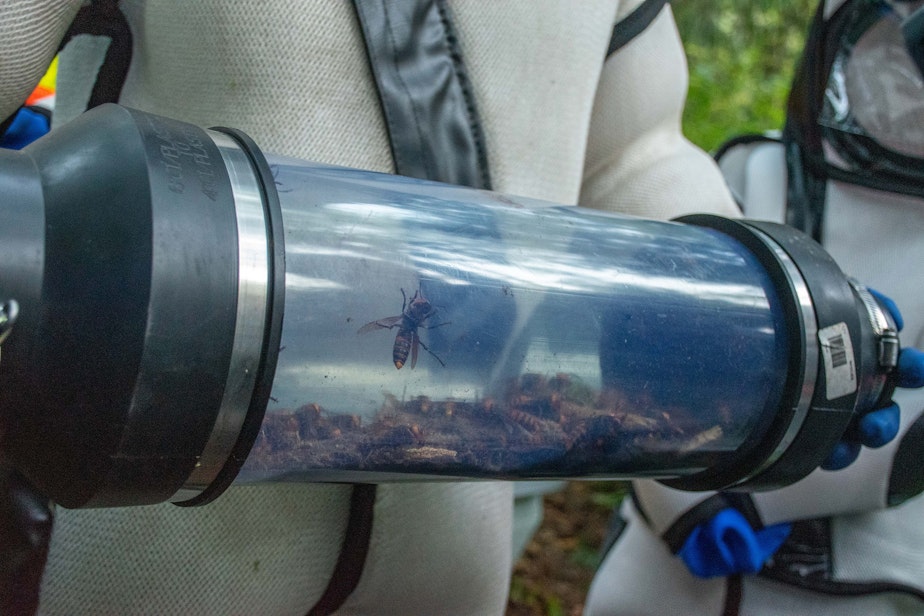Nest with nearly 1,500 Asian giant hornets destroyed near Blaine
A team outfitted in sting-proof foam suits eradicated a nest of the world’s largest hornets near Blaine, Washington, and the U.S.-Canada border on Wednesday.
It is the first Asian giant hornet nest to be destroyed in 2021.
The foamed trio vacuumed up 113 adult Asian giant hornets and removed 1,277 younger hornets from the nest inside a dead alder tree. They also netted another 67 flying near the nest, according to the Washington State Department of Agriculture.
The hornets did not take it well.
Their nest under assault, some knocked a new exit out of the crumbling alder wood and took to the air to launch a counterattack.
Stings from the giant insects sometimes called "murder hornets" are known to cause intense pain and overwhelming swelling.
But the hornets’ quarter-inch long stingers were no match for the even thicker foam outfits the nest eradicators wore.

 1 min
Asian giant hornet larvae make scratching sounds inside their six-sided cells in a hornets' nest found near Blaine, Washington, on Wednesday. The larvae are believed to make the sounds to attract adults to feed them.
1 min
Asian giant hornet larvae make scratching sounds inside their six-sided cells in a hornets' nest found near Blaine, Washington, on Wednesday. The larvae are believed to make the sounds to attract adults to feed them.
“They just bounced right off of our lovely suits,” entomologist Sven-Erik Spichiger said. “No injuries sustained at all.”
Spichiger said the head-to-toe foam suits can get “a little warm on the inside.”
“They are fairly uncomfortable, but it’s got to be more comfortable than being stung, so we’re always happy to make that tradeoff,” he said.
Entomologists located the nest about two miles from the nest they destroyed in October and a quarter mile from the Canada border.
This year’s nest had three times as many hornets as last year’s, and officials urged the public in the northwest corner of Washington state to stay on the lookout for the large, distinctive hornets.
Sponsored
U.S. and Canadian officials have been on high alert to keep the invasive insects from spreading since they were first detected on Vancouver Island in 2019.
The hornets have a habit of decapitating their prey, and a small group can quickly wipe out a whole hive of honey bees — on which many farmers depend to pollinate their crops — in just a matter of hours.
A Blaine-area homeowner reported seeing a live Asian giant hornet on Aug. 11. Hornet trackers caught three hornets nearby and tied tiny radio-tracking devices on them with Kevlar thread in hopes of locating their nest.
One hornet slipped its Kevlar noose. Another disappeared, last seen heading toward Canada. Canadian officials tried to track it down north of the border, but no luck.
“We have spent an awful lot of [time] crawling through bramble bushes and very rough terrain straight north of the suspected area where the tagged hornet had crossed the border,” said Paul van Westendorp with the British Columbia Ministry of Agriculture, Food and Fisheries. “We searched far and wide and everywhere but no hornets were found.”

The third tagged hornet led the pest-control team to the nest.
After the hornets were spotted, but before their nest was located, a homeowner reported a group of the giant hornets attacking paper wasps in the eaves of their home.
“They were simply grabbing all of the paper wasps and chopping their heads off, dropping them to the ground, and then harvesting from that paper wasp nest,” Spichiger said. “This is what is actually described as the ‘slaughter phase’ behavior that obviously we are worried about with our honeybee population.
Spichiger said the landowners near Blaine who spotted the hornets and let entomologists go hornet hunting all around their rural property asked not to be contacted by the media.
Spichiger said he was excited to learn that the hornets were attacking paper wasp nests that were out of sight, meaning that the hornets were probably attracted to their prey by some biochemical odor wafting through the air.
Sponsored
Some of the younger hornets from the eradicated nest were kept alive and shipped off to a secure U.S. Department of Agriculture laboratory in Wapato, Washington.
Researchers there hope to find what smells might attract the hornets to make them easier to find, and eradicate, in the future.




